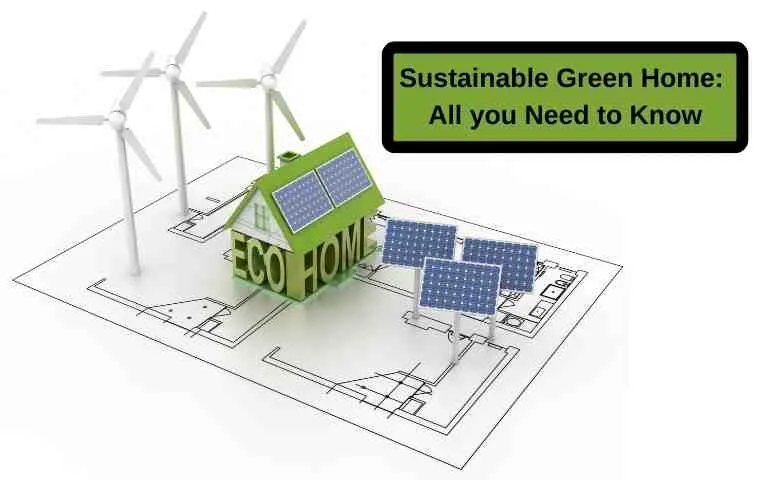Last Updated on August 11, 2022 by Admin
A blog post about sustainable green homes and how they can help you save money, energy, and resources. It includes everything you need to know before going green and tips on how to get started.
Green building has become more profitable and sought-after in the global construction market as demand for more environmentally friendly building options rises. As a result, green housing is revolutionizing the housing market and enhancing our quality of life. Beyond construction and efficiency, green homes contribute to healthier neighborhoods that advance our social, economic, and environmental well-being.
Table of Contents
What is a Green Home?
A ‘green’ building is one that, through its design, construction, or operation, reduces or eliminates adverse impacts on our climate and natural environment while also having the potential to create positive effects. Green buildings protect valuable natural resources while also improving our quality of life.
A home can be “green” by having a variety of features. These consist of:
- Efficient use of resources such as energy, water, and others
- Using sustainable energy sources like solar energy
- Efforts to reduce waste and pollution as well as to promote recycling and reuse
- Satisfactory indoor air quality
- Using non-toxic, moral, and sustainable materials
- Environmental considerations in construction, design, and operation
- Taking into account the occupants’ quality of life during design, construction, and operation
- A structure that allows for environmental adaptation.
Green Home Benefits
Healthier and more natural ventilation system: Green buildings emphasize natural ventilation using “breathable” construction materials and low-energy fans to maintain ventilation.
Energy efficiency: Through the provision of low-energy household appliances such as refrigerators and better window placement to allow more natural light into the home.
Durability: Green homes are made with natural materials that last longer than concrete, plywood, and steel.
Better indoor air quality: Green homes have air filters that reduce dust, pollen, and other pollutants.
Less material usage: By cutting energy bills, optimizing material use, and reducing landfill waste, green homes minimize waste and carbon emissions
Temperature control: Thanks to a combination of design and sustainable materials made from recycled products, green homes have better air quality and fewer fluctuations in temperature.
Sustainable Home Design Trends
Solar Power
In the United States, solar energy is more widely available, less expensive, and more widespread than ever. As a result, you can now run your home almost entirely on solar power from your neighborhood.
Why use solar energy? It is an entirely clean and renewable source of energy. This lessens the need for coal, natural gas, and oil in electricity production.
Sustainable textiles
Naturally, sourced fabrics may not have crossed your mind initially, but they are an essential component of green interior design. Hemp, seagrass, unprocessed cotton, and banana fiber are some of these materials. These materials promote sustainability while giving your home a distinctive feel. Finding eco-friendly products is now simpler than ever, thanks to their rising popularity.
Window tinting for homes
If you reside in a region with extremes of temperature throughout the year, you are aware of the potential harm to your HVAC system. By getting your home’s windows tinted, you can reduce summer heat gain and trap heat indoors during the winter. This will help you save energy costs by steadily maintaining your home’s temperature.
Technology for Smart Homes
It promotes sustainable living by reducing new energy costs and is more cost-effective. You can schedule appliances, manage lights, and enter your home with a smartphone. Global consumer trends reflect the increasing internet savvy of the world.
Small Houses
Consider relocating to a tiny house if you want to reduce your carbon footprint. This is a fantastic way to spend less money, live more simply, and have greater mobility.
Organic Furniture
Natural furniture can improve your living space in a similar way that eco-friendly fabrics can. Find wicker and rattan furniture to decorate your home with for a bohemian touch. This furniture adds texture to your decor in addition to being sustainable.
Location
Choosing a conveniently close residence to public transportation can reduce the emissions of private vehicles.
Use Green Building Materials
Making your home greener can largely be accomplished using recycled or energy-efficient materials. If you want to make your next home design project more environmentally friendly, consider using these materials:
- Deconstructed materials from previous construction projects: flooring, reclaimed brick, and wood paneling.
- Aluminum: This is sturdy, corrosion-resistant, and completely recyclable. It is a flexible metal that works well for many different designs.
- Bamboo: It’s incredibly durable and much more environmentally friendly than other types of wood.
What Is a Green Home Inspection?
Because a home inspector must consider components of a property that are designed to be energy efficient and reduce electricity costs, a green home inspection differs from a traditional home inspection. Home inspectors must know how sustainable materials affect the house’s overall functionality and how to identify “green features” in a property.
Like during a regular home inspection, every part of a green home should be checked. Although a green home inspection might not check all components thoroughly, its goal is to ensure that all “green” aspects are covered.
According to InterNACHI, these features typically include energy-efficient appliances and installations, sustainable materials, and a home’s features that promote human and environmental health.
Building sustainably is challenging but becoming more crucial. Spend some time learning everything there is to know about green living or make sure you hire a contractor who has received training in building science.
Conclusion
Making your home sustainable and green is a great way to help the environment and save money. You can do many things to make your home more sustainable, from using energy-efficient appliances to installing solar panels. With a little effort, you can make your home more sustainable and green while still enjoying all the comforts of modern living. Thanks for reading!


